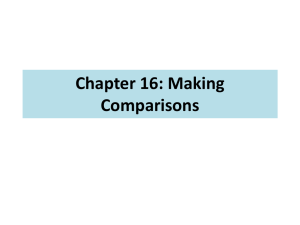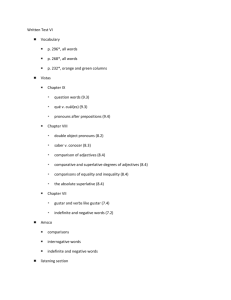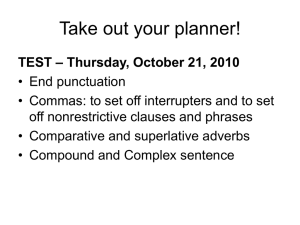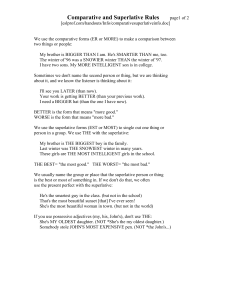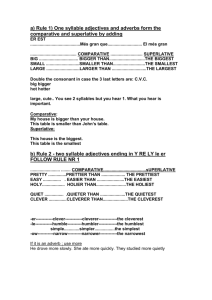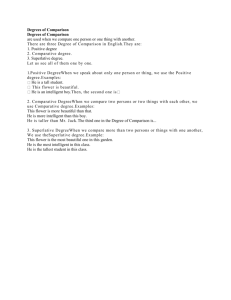Many Hadas Kotek, Yasutada Sudo and Martin Hackl 1 Most
advertisement
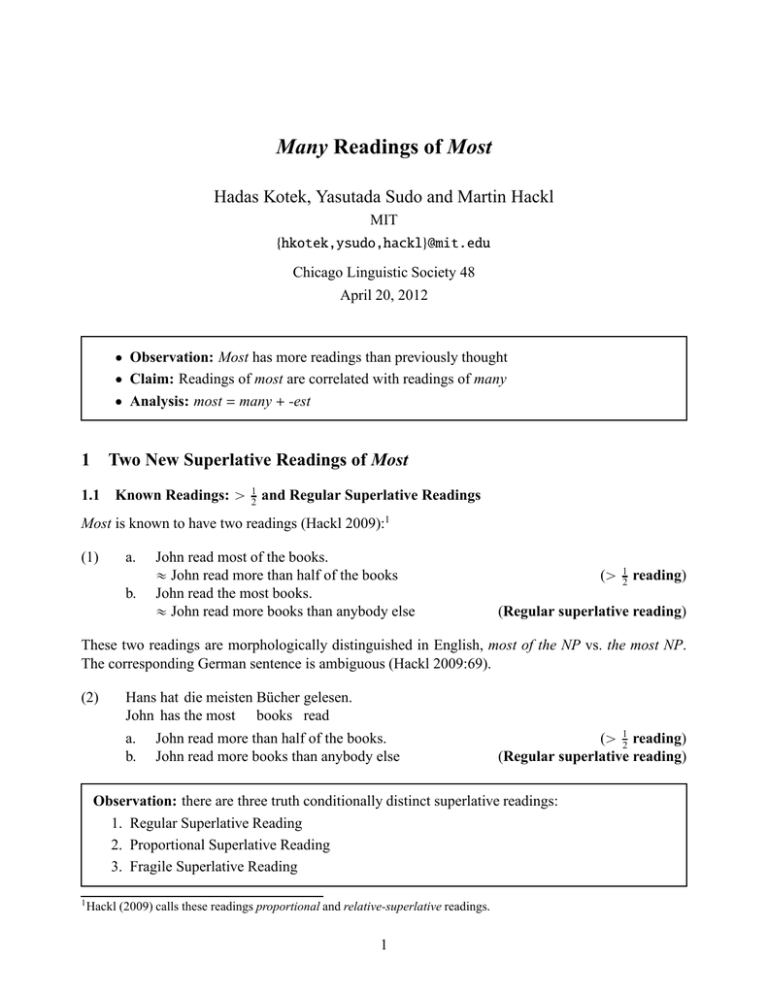
Many Readings of Most
Hadas Kotek, Yasutada Sudo and Martin Hackl
MIT
{hkotek,ysudo,hackl}@mit.edu
Chicago Linguistic Society 48
April 20, 2012
• Observation: Most has more readings than previously thought
• Claim: Readings of most are correlated with readings of many
• Analysis: most = many + -est
1 Two New Superlative Readings of Most
1.1 Known Readings: ą
1
2
and Regular Superlative Readings
Most is known to have two readings (Hackl 2009):1
(1)
a.
b.
John read most of the books.
« John read more than half of the books
John read the most books.
« John read more books than anybody else
(ą
1
2
reading)
(Regular superlative reading)
These two readings are morphologically distinguished in English, most of the NP vs. the most NP.
The corresponding German sentence is ambiguous (Hackl 2009:69).
(2)
Hans hat die meisten Bücher gelesen.
John has the most books read
a.
b.
John read more than half of the books.
John read more books than anybody else
(ą 12 reading)
(Regular superlative reading)
Observation: there are three truth conditionally distinct superlative readings:
1. Regular Superlative Reading
2. Proportional Superlative Reading
3. Fragile Superlative Reading
1
Hackl (2009) calls these readings proportional and relative-superlative readings.
1
The latter two were not discussed in the literature.2
1.2 Proportional Superlative Reading
We observe that (3) is ambiguous between two superlative readings:
(3)
Mali has the most illiterate people.
a. Regular Superlative
|illiterate people in Mali| ą |illiterate people in x|, for all other countries x
b.
Proportional Superlative
|illiterate people in Mali|
|illiterate people in x|
ą
, for all other countries x
|people in Mali|
|people in x|
A proportional superlative reading compares proportions, while a regular superlative reading compares simple cardinalities.
These two readings are truth conditionally independent. In the situation (4), both (5a) and (5b) are
true.
(4)
a.
b.
c.
Mali has 10 million illiterate people (74%)
Afghanistan has 18.5 million illiterate people (62%)
Pakistan has 74 million illiterate people (42%)
(5)
(Of these three countries)
a. Pakistan has the most illiterate people.
b. Mali has the most illiterate people.
True under regular superlative
True under proportional superlative
1.3 Fragile Superlative Reading
In Kotek, Sudo, Howard, and Hackl (2011a), we observed that most of the NP in subject position has
a latent superlative reading. The acceptability of (6b) varies across speakers.
(6)
Most of the dots are blue.
a. « More than half of the dots are blue
b. « For any non-blue color C, |blue dots| ą |C dots|
(ą 21 Reading)
(Superlative Reading)
(6a) asymmetrically entails (6b), so in a situation like (7), only (6b) is true.
(7)
6 blue dots, 4 yellow dots, 3 red dots, 3 green dots
We claim that the superlative reading we identified in Kotek et al. (2011a) is truth conditionally
distinct from the regular superlative reading. The difference between the two superlative readings
emerges when there are many alternative colors.
A fragile superlative reading breaks as the number of relevant individuals increases, unlike a regular superlative reading
2
In Kotek, Sudo, Howard, and Hackl (2011b) we identified yet another type of superlative reading, a superlative reading
with a partition effect. We do not discuss it in this talk.
2
For example, the superlative reading of (8) is judged true in (8a) and false in (8b) (note also that the
ą 12 reading is false).3
(8)
Most of the dots are blue.
a. 6 blue dots, 4 yellow dots, 3 red dots, 3 green dots
b. 6 blue dots, 4 yellow dots, 3 red dots, 3 green dots, 3 white dots, 3 pink dots, 3 brown
dots
(9) has a regular superlative reading, which is true in both situations.
(9)
Mr. Blue has the most dots.
1.4 Summary and Preview of the Analysis
Most has three superlative readings (in addition to the ą 21 reading):
• Regular superlative reading: Compares of simple cardinalities
• Proportional superlative reading: Comparison of proportions
• Fragile superlative reading: Similar to regular superlative but breaks
Following Hackl (2009), we analyze most as the spell-out of many + -est (cf. Bresnan 1973).4 We
claim that the three superlative readings stem from the ambiguity of many.
2 Parallel Ambiguities of Many and Most
Many is known to have three readings (Westerståhl 1984, Löbner 1987, Partee 1989, Büring 1996,
Herburger 1997, Cohen 2001, Solt 2009, Krasikova to appear).
1. Cardinal Reading
(10)
John wrote many papers last year.
« |papers John wrote last year| is large
2. Proportional Reading
(11)
3
4
Many graduate students in this department are from Europe.
Fullwood, Kotek, Sudo and Hackl (in progress) for experimental work on this.
See also our earlier work Kotek, Sudo, Howard, and Hackl (2011a,b).
3
«
|European graduate students|
is large
|graduate students|
3. ‘Focus Affected’ (FA) Reading5
(12)
Many cooks applied.
«
(adopted from Herburger 1997:61)
|cooks among the applicants|
is large
|applicants|
For the purposes of this talk we do not make any assumptions about how these readings are accounted
for (see Büring 1996, Cohen 2001, Herburger 1997, Solt 2009, Krasikova to appear). Also we do not
justify the distinction among the three readings (see the works cited in this section).
Idea: The three superlative readings of most are based on the three readings of many:
Many
Superlative Most
Cardinal
ñ Regular Superlative
FA
ñ Proportional Superlative
Proportional ñ Fragile Superlative
2.1 Distributions of Three Manys
It is known that the three readings of many are not available everywhere. In particular, the weak vs.
strong distinction is relevant (Partee 1989, Büring 1996, Cohen 2001, Herburger 1997, Solt 2009).
Roughly,
• Weak Environments: Cardinal and FA many only
• Strong Environments: Proportional many only
(and in neutral contexts, all three readings are available)
Most existential determiners have both weak and strong readings. Certain constructions force either
one of the readings. Also there are determiners that are obligatorily weak or strong, that can be used
as diagnostics for weak/strong environments (Postal 1966, Milsark 1977, Diesing 1992, Anderssen
2011)
(13)
5
Obligatorily weak determiners
a. sm (vs. some)
b. unstressed a
c. non-generic bare plurals
(14)
aka ‘reverse proportional’ reading.
4
Obligatorily strong determiners
a. every, each
b. partitives
2.2 Weak Environments
In contexts where weak readings are forced, strong quantifiers like every NP and partitives cannot
appear.6
• There-sentences
(15)
a. There are sm students in the office.
b. *There are some (of the) students in the office.
c. *There are every student in the office.
• Possessive constructions
(16)
a. I have sm cousins in California.
b. #I have some (of the) cousins in California.
c. #I have every cousin in California.
In these contexts, many has a cardinal or FA reading, but not a proportional reading.
(17)
Cardinal Many
a. There are many students in Room A.
b. I have many cousins.
(18)
FA Many
a. There are many illiterate people in Mali.
b. Mali has many illiterate people.
|illiterate people in Mali|
ľ ds
|people in Mali|
Correspondingly, most has a regular superlative or FA superlative reading but not a fragile superlative
reading (superlative readings generally require a focus).
(19)
Regular Superlative Most
a. There are the most students in [Room A]F .
b. [I]F have the most cousins.
(20)
FA Superlative Most
a. There are the most illiterate people in [Mali]F .
b. [Mali]F has the most illiterate people.
|illiterate people in Mali|
|illiterate people in x|
ľ
for all the other countries x
|people in Mali|
|people in x|
The fragile superlative reading is not available in these environments. Since the fragile superlative
reading is stronger than the regular superlative reading (the former asymmetrically entails the latter),
it is harder to see that it’s absent in an upward entailing context. So let’s embed the sentence in a
downward entailing context.
6
Other weak environments include: de dicto objects of creation verbs and intensional transitive predicates, the object of
the “reflexive possessor raising construction” (have oneself ... X).
5
(21)
a.
b.
I doubt that there are the most illiterate people in [Mali]F .
I doubt [Mali]F has the most illiterate people.
If these sentences have a fragile superlative reading, they will become compatible with believing the
following inequality as the number of relevant countries increases. But their truth conditions are
insensitive to this manipulation.
(22)
|illiterate people in Mali|
|illiterate people in x|
ľ
for all the other countries x
|people in Mali|
|people in x|
Compare this to the fragile superlative reading of (23).
(23)
a.
b.
I doubt that most of the illiterate people are in [Mali]F
I doubt that most of the dots are [blue]F
2.3 Strong Environments
In strong environments, obligatorily weak determiners like sm are ungrammatical.7
• Subjects of individual-level predicates (Carlson 1977)
(24)
a. *sm students are tall.
b. Some (of the) students are tall.
• De re phrases (Musan 1995, Keshet 2008)
(25)
a. #sm graduate students were born in 1990.
b. Some (of the) graduate students were born in 1990.
• Partitives
(26)
a. *sm of the people are semanticists
b. Some of the people are semanticists
We expect that many only has a proportional reading in these contexts, and correspondingly, most
only has a fragile superlative reading (and a ą 21 reading).
However, because of the vagueness of the standard, it is hard to make sure that a given situation makes
cardinal many false and proportional many true, or vice versa (cf. Partee 1989).
7
Other strong environments include: subjects of psychological state predicates like be nervous, object of hate, object of
secondary predicate constructions, German scrambling.
6
Huettner’s test: Cardinal many is compatible with all but proportional many implicates not all.
(27)
(28)
a.
Many grad students are from California.
{ Not all of them are from California.
b.
Many grad students are in California right now.
(no implicature of many)
a.
Many of the grad students are in California right now.
{ Not of all of them are in California right now.
b.
Many grad students were born in 1990.
{ Not all of them were born in 1990.
Most of the NP, being partitive, only has a fragile superlative reading.8
(29)
Most of the grad students are in California right now.
a. CA 6, MA 4, HW 4
b. CA 6, MA 4, HW 4, TX 4, IL 4, UT 4, MD 4, NY 4
Most NP strongly prefers a generic interpretation (Matthewson 2001).9
2.4 Section Summary
We observed:
• Weak environments:
– Many: Cardinal and FA
– Most: Regular superlative and proportional superlative
• Strong environments:
– Many: Proportional
– Most: Fragile superlative
This supports the correlation between many and most:
(30)
Many
Superlative Most
Cardinal
ñ Regular Superlative
FA
ñ Proportional Superlative
Proportional ñ Fragile Superlative
3 Decompositional Analysis
3.1 Review of Hackl (2009)
Hackl proposes to decompose most into many and the superlative operator -est (cf. Bresnan 1973).
8
In object position, the fragile superlative reading of most of the NP is less prominent, but seems to be available (at least
for some speakers), e.g. %[John]F read most of the books.
9
In principle, one can get generic superlative readings of most NP and we expect them to break in strong environments. This appears to us to be on the right track, but the judgments are inconclusive: e.g. Most endangered species
are [reptiles]F , Most graduate students were born in [1990]F .
7
(31)
most = many + -est
Hackl postulates the same structure for the phrases in (32).
DP
(32)
a.
b.
most of the books
the most books
D
NP
D
-est
many
books
The semantics of the items involved are:10
(33)
v many wpdqpxq ô |x| ľ d
v -est wpCqpPxd,ety qpxq ô DdrPpdqpxq ^ @y P Crx ‰ y Ñ
v D wpPqpQq ô P X Q ‰ H
a.
b.
c.
Ppdqpyqss
Because of the type mismatch between many and -est, -est undergoes covert movement.
Hackl shows how to derive the ą 12 and regular superlative readings by differentiating the scope of
-est and the comparison class C.
3.1.1 ą
(34)
1
2
Reading
John read most of the books
Ignoring QR of the object, the LF of (34) looks like (35).
(35)
John
read
DP
NP
D
D
-estC
λd
d
10
books
many
In addition -est presupposes: (i) x P C, (ii) |C| ą 1, and (iii) @y P CDdrPpdqpyqs.
8
According to the lexical entries above,
4
<
NP
(36)
6
>
6
>
6 -estC
>
6
>
6
>
λd
5
=
books
d many
“ λX. Ddrd-many-bookspXq ^ @Y P CrX ‰ Y Ñ
pd-many-bookspYqqss
It is assumed: C is a non-overlapping cover of v books w.
The overall truth conditions are:
(37)
DdDXrd-many-bookspXq ^ ˚ rreadp jqspXq ^ @Y P CrX ‰ Y Ñ
pd-many-bookspYqqss
ô John read more than half of the books
3.1.2 Regular Superlative Reading
The regular superlative reading of (38) is assumed to involve the same lexical items, but the LF
position of -est is outside of the local DP as in (39).
(38)
John read the most books
(39)
John
-estC
λd
read
DP
NP
D
D
d
books
many
The comparison class is assumed to be alternatives to John:11
11
e.g. C “ tJohn, Bill, Maryu
We tacitly assume that the alternative set C is a function of the focus (Szabolcsi 1986, Heim 1999, Kotek et al. 2011b).
9
The VP denotation looks as follows.
<
4
VP
(40)
>
6
>
6
>
6 -estC
>
6
>
6
λd
>
6
>
6
read
DP
>
6
>
6
>
6
>
6
NP
D
>
6
>
6
=
5
D
books
d many
„
DXrd-many-bookspXq ^ readpz, Xq^
“ λz. Dd
@z1 rz ‰ z1 Ñ DYrd-many-bookspYq ^ readpz1 , Yqsss
The overall truth conditions are:
(41)
Dd
„
DXrd-many-bookspXq ^ ˚ rreadp jqspXq^
@z P Cr j ‰ z Ñ DYrd-many-bookspYq ^ ˚ rreadpzqspYqsss
ô John read more books than Bill did and John read more books than Mary did
3.2 Proportional Superlative Reading
Given an appropriate semantics of FA many, the decompositional analysis of most derives the proportional superlative reading of most.
|illiterate people in Mali|
(42)
a. Mali has many illiterate people.
ľ ds
b.
|people in Mali|
Let us assume that many has a reading in (43a) (possibly not as an atomic lexical item).
(43)
a.
v manyFA wpDqpdqpXq ô
b.
D “ people in Mali
|X|
ľd
|D|
c.
Mali
has
DP
D
NP
D
pos manyFA
D
10
illiterate people
The predicted truth conditions are:
„
(44)
DX illiterate-peoplepXq ^
|X|
ľ ds
|people in Mali|
With the above semantics of manyFA , and an assumption that D can be dependent on the subject, the
proportional superlative reading is derived via the same mechanism that Hackl (2009) uses.
(45)
Mali has the most illiterate people.
(46)
Mali
-estC
λd
λx
x
has
DP
NP
D
D
d
(47)
a.
b.
manyFA Dx
illiterate people
D x “ people in x
C “ tMali, Afghanistan, Pakistanu
The predicted truth conditions are:
(48)
»
—
—
DdDX —
–
|X|
illiterate-in-MalipXq ^
ľ d^
|people in Mali|
„
„
@z P C Mali ‰ z Ñ DY ˚ illiterate-in-zpYq ^
fi
˚
ô for z P tAfghanistan, Pakistanu,
|Y|
ľd
|people in z|
ffi
ffi
ffi
fl
|illiterate people in Mali|
|illiterate people in z|
ą
|people in Mali|
|people in z|
3.3 Fragile Superlative Reading
It turns out that it is not as straightforward to derive the fragile superlative reading from proportional
many.
|blue dots|
(49)
a. Many of the dots are blue
b.
ľ ds
|dots|
(50)
a.
v manyP wpdqpPqpXq ô
|X|
ľd
|P|
where P is the NP denotation
11
b.
DP
NP
D
D
pos manyP
of the dots
The problem for most is that if the denominator is constant across alternatives, the resulting truth
conditions will be identical to the regular superlative reading (see Kotek et al. 2011b for how to
account for a superlative reading in subject position).
(51)
Most of the dots are [blue]F .
C is a set of alternative colors:
(52)
a.
b.
C1 “ tblue, red, yellow, greenu
C2 “ tblue, red, yellow, green, white, pink, brownu
(53)
»
—
—
DdDX —
–
ô
|X|
ľ d^
blue-dotspXq ^
|dots|
„
„
|Y|
˚
ľd
@P P C blue ‰ P Ñ DY P-dotspYq ^
|dots|
˚
|P dots|
|blue dots|
ą
|dots|
|dots|
fi
ffi
ffi
ffi
fl
for other colors P P C
But this is truth conditionally equivalent to a regular superlative reading:
|P dots|
|blue dots|
ą
for other colors P P C
(53) ô
|dots|
|dots|
We suggest that the relation ą that many expresses is coarse:
For p ą q to be true, p needs to be sufficiently larger than q.
When |dots| is large, the difference between
|P dots|
|blue dots|
and
will be small.
|dots|
|dots|
(54)
p
6
4
6
3
ą q^p ą q
16
16
16
16
ô
p.375 ą .25q ^ p.375 ą .1875q
12
(55)
p
6
4
6
3
ą q^p ą q
25
25
25
25
ô
p.24 ą .16q ^ p.24 ą .12q
(56)
1
6
ą
14
14
ô
.429 ą .071
We are currently working on the nature of this breaking phenomenon using experimental methods
(Fullwood, Kotek, Sudo and Hackl, in progress).
4 Conclusions
• Observation: Most has more readings than previously thought
– Three superlative readings: regular, proportional, fragile
– ą 21 reading
• Claim: The three superlative readings of most are parallel to the three readings of many
• Analysis: Hackl’s decompositional analysis (most = many + -est) gives an account of the three
superlative readings
4.1 ą
1
2
Reading
Under the proposed analysis the ą 12 reading is expected to be three-way ambiguous as well due to the
three-way ambiguity of many. It turns out that all three manys give rise to the same truth conditions
when -est says in the DP.
(57)
NP
-estC
λd
d
(58)
many
books
Cardinal Many
λX. DdrbookspXq ^ |X| ľ d ^ |@Y P CrX ‰ Y Ñ
(59)
pbookspYq ^ |Y| ľ dqss
FA Many
λX. DdrbookspXq ^
|X|
ľ d ^ |@Y P CrX ‰ Y Ñ
|D|
13
pbookspYq ^
|Y|
ľ dqss
|D|
(60)
Proportional Many
λX. DdrbookspXq ^
|X|
ľ d ^ |@Y P CrX ‰ Y Ñ
|books|
pbookspYq ^
|Y|
ľ dqss
|books|
That is, under the latter two readings, the denominators are the same between the two fraction terms,
and therefore they don’t affect the truth conditions.12
Note also that with the partitive structure most of the NP, it is expected that only (60) is available, and
the most NP seems to force -est to move outside (cf. Szabolcsi 1986, Hackl 2009).
Also given the coarseness of ą, our analysis might give an account of the difference between the
ą 21 most and more than half : the judgments for most are less sharp than more than half when the
difference between two sets is small.13
4.2 Fewest
Fewest has a regular and a FA superlative reading.
(61)
Pakistan has the fewest illiterate people.
a. Regular Superlative:
For any other country y, |illiterate people in Pakistan| ă |illiterate people in y|
b. FA Superlative
|illiterate people in Pakistan|
|illiterate people in y|
For any other country y,
ă
|people in Pakistan|
|people in y|
Whether fewest has a fragile superlative reading is not testable: the reading is not expected to break.
Fewest also lacks an otherwise expected ă 12 reading (see Hackl 2009 for an explanation).
One puzzling difference between most and fewest: *Fewest of the NP is ungrammatical (butfew of the
NP is grammatical).
4.3 More
More has readings based on cardinal and FA many (Partee 1989):
(62)
a.
b.
There are more illiterate people in Pakistan than in Mali.
There are more illiterate people in Mali than in Pakistan.
True under cardinal reading
True under FA reading
It seems that more does not allow a proportional reading.
(63)
Mali has more illiterate people than Pakistan does.
References
Anderssen, Jan. 2011. Quantification, misc. Doctoral Dissertation, University of Massachusetts,
Amherst.
12
It is not immediately clear what the appropriate value of D would be in this case, but it cannot be quantified into by -est
unlike in the case of the proportional superlative reading.
13
See Solt (2011) and our unpublished work (Sudo, Kotek and Hackl, to be presented at CogSci 2012) for quantitative
data.
14
Bresnan, Joan. 1973. Syntax of the comparative clause construction in English. Linguistic Inquiry
4:275–343.
Büring, Daniel. 1996. A weak theory of strong readings. In SALT 6.
Carlson, Gregory. 1977. Reference to Kinds in English. Doctoral Dissertation, University of Massachusetts, Amherst.
Cohen, Ariel. 2001. Relative readings of many, often, and generics. Natural Language Semantics
9:41–67.
Diesing, Molly. 1992. Indefinites. Cambridge, MA: MIT Press.
Hackl, Martin. 2009. On the grammar and processing of proportional quantifiers: most versus more
than half . Natural Language Semantics 17:63–98.
Heim, Irene. 1999. Notes on superlatives. Ms., Massachusetts Institute of Technology.
Herburger, Elena. 1997. Focus and weak noun phrases. Natural Language Semantics 5:53–78.
Keshet, Ezra. 2008. Good Intensions: Paving Two Roads to a Theory of the De re/De dicto Distinction.
Doctoral Dissertation, Massachusetts Institute of Technology.
Kotek, Hadas, Yasutada Sudo, Edwin Howard, and Martin Hackl. 2011a. Most meanings are superlative. In Syntax and Semantics 37: Experiments at the Interfaces, ed. Jeff Runner, 101–146. New
York: Academic Press.
Kotek, Hadas, Yasutada Sudo, Edwin Howard, and Martin Hackl. 2011b. Three readings of most. In
Proceedings of SALT 21, 353–372.
Krasikova, Sveta. to appear. On proportional and cardinal ‘many’. In Proceedings of Swiss Workshop
in Generative Grammar 11.
Löbner, Sebastian. 1987. Quantification as a major module of natural language semantics. In Studies
in Discourse Representation Theory and the Theory of Generalized Quantifiers, ed. Jeroen Groenendijk, Dick de Jongh, and Martin Stokhof, 53–85. Dordrecht: Foris.
Matthewson, Lisa. 2001. Quantification and the nature of cross-linguistic variation. Natural Language
Semantics 9:145–189.
Milsark, Gary. 1977. Existential Sentences in English. Doctoral Dissertation, Massachusetts Institute
of Technology.
Musan, Renate. 1995. On the Temporal Interpretation of Noun Phrases. Doctoral Dissertation, Massachusetts Institute of Technology.
Partee, Barbara. 1989. Many quantifiers. In Proceedings of the 5th ESCOL, 383–402.
Postal, Paul. 1966. On so-called ‘pronouns’ in english. In Report on the Seventeeth Annual Round
Table Meeting on Linguistics and Language Studies, ed. Francis Dinneen, 177–206. Washington,
D.C.: Georgetown University Press.
Solt, Stephanie. 2009. The Semantics of Adjectives of Quantity. Doctoral Dissertation, The City
University of New York.
Solt, Stephanie. 2011. On quantification and measurement: the case of most and more than half . Ms.,
ZAS.
Szabolcsi, Anna. 1986. Comaprative superlatives. In Papers in Theoretical Linguistics, ed. Fukui
Naoki, Tova Rapoport, and Elizabeth Sagey, 245–266. MIT Working Papers in Linguistics.
Westerståhl, Dag. 1984. Determiners and context sets. In Generalized Quantifiers and Natural Language, ed. John van Benthem and Alice ter Meulen. Dordrecht: Foris.
15

